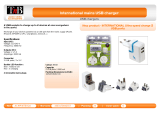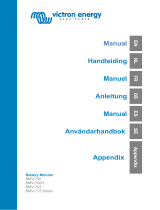
Table of Contents
1. Introduction ............................................................................................................................. 4
1.1. What is the Venus GX? ..................................................................................................... 4
1.2. What's in the box? ........................................................................................................... 4
2. Installation .............................................................................................................................. 6
2.1. Overview of connections .................................................................................................... 6
2.2. Power ......................................................................................................................... 6
2.3. Connecting Victron products ............................................................................................... 7
2.3.1. Multis/Quattros/Inverters (VE.Bus products) ................................................................... 7
2.3.2. Battery Monitor BMV-700 series; and MPPTs with a VE.Direct port ......................................... 8
2.3.3. Skylla-i, Lynx Shunt VE.Can, Lynx Ion + Shunt and MPPTs with a VE.Can port .......................... 8
2.3.4. BMV-600 series .................................................................................................... 8
2.3.5. DC Link box ........................................................................................................ 8
2.3.6. VE.Can Resistive Tank Sender Adapter ........................................................................ 8
2.4. NMEA Tank senders from other manufacturers .......................................................................... 8
2.5. Connecting a PV Inverter ................................................................................................... 9
2.6. Connecting a USB GPS .................................................................................................... 9
2.7. Connecting a Fischer Panda Generator .................................................................................. 9
2.8. Connecting NMEA 2000 tank senders .................................................................................... 9
2.9. Connecting IMT Solar Irradiance, Temperature and Wind Speed Sensors ......................................... 10
2.9.1. Data Visualisation - VRM ....................................................................................... 14
2.10. Connecting Temperature Sensors ..................................................................................... 15
2.11. Connecting Tank Level Sensors ........................................................................................ 15
3. Internet connectivity ................................................................................................................. 16
3.1. Ethernet LAN port ......................................................................................................... 16
3.2. Wi-Fi ........................................................................................................................ 16
3.3. GX GSM .................................................................................................................... 17
3.4. Mobile (cellular) network using a 3G or 4G router ..................................................................... 17
3.5. USB tethering using a mobile phone .................................................................................... 17
3.6. IP Configuration ........................................................................................................... 18
3.7. Connecting both Ethernet and Wi-Fi (failover) ......................................................................... 18
3.8. Minimize internet traffic ................................................................................................... 18
3.9. More information about setting up an internet connection and VRM ................................................ 19
4. Accessing the GX device ........................................................................................................... 20
4.1. Accessing via the built-in WiFi Access Point ........................................................................... 20
4.2. Accessing Remote Console via the local LAN/WiFi Network ........................................................ 20
4.2.1. Alternative methods to find the IP Address for Remote Console .......................................... 21
4.3. Accessing via VRM ........................................................................................................ 23
5. Configuration ......................................................................................................................... 25
5.1. Menu structure and configurable parameters .......................................................................... 25
5.2. Battery State of Charge (SOC) .......................................................................................... 29
5.2.1. Which device should I use for SOC calculation? ............................................................ 29
5.2.2. The different solutions explained in detail .................................................................... 29
5.2.3. Notes on SOC ................................................................................................... 30
5.2.4. Selecting SOC source .......................................................................................... 30
5.2.5. Details on VE.Bus SOC ........................................................................................ 32
5.3. Customize the logo on the Boat & Motorhome page .................................................................. 32
5.4. LEDs and Push-button .................................................................................................... 32
5.4.1. LEDs .............................................................................................................. 32
5.4.2. Small button located to the right of the green 14-Terminal Connector Block ............................. 32
6. Updating GX Firmware .............................................................................................................. 33
6.1. Via internet or with microSD-card/USB-stick ........................................................................... 33
6.2. Direct download from the internet ....................................................................................... 33
6.3. MicroSD-card or USB-stick ............................................................................................... 33
6.4. Changelog .................................................................................................................. 34
7. VE.Bus Inverter/charger monitoring ............................................................................................... 35
7.1. Input current-limiter setting ............................................................................................... 35
7.2. Phase rotation warning ................................................................................................... 36
7.3. Grid failure monitoring .................................................................................................... 37
7.4. Advanced menu ........................................................................................................... 38
8. DVCC - Distributed Voltage and Current Control ................................................................................ 39
8.1. Introduction and features ................................................................................................. 39
8.2. DVCC Requirements ...................................................................................................... 40
8.3. DVCC effects on the charge algorithm .................................................................................. 40
8.4. DVCC features for all systems ........................................................................................... 41
8.4.1. Limit charge current ............................................................................................. 41
8.4.2. Shared Voltage Sense (SVS) .................................................................................. 41
Venus GX Manual
2























